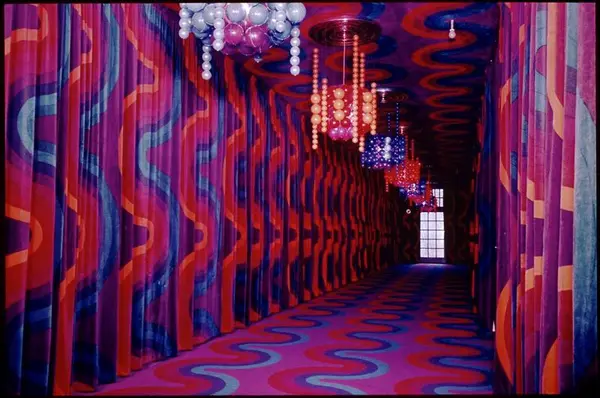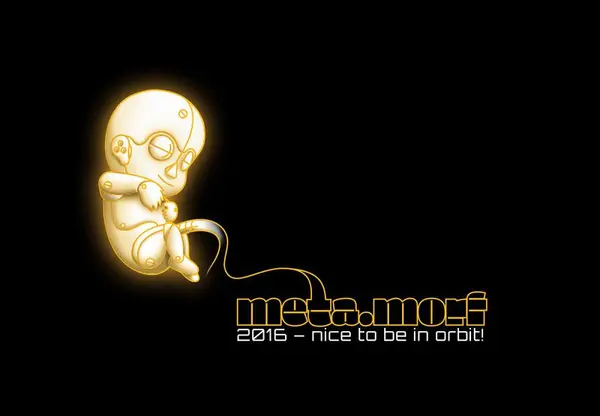A spectacular interior by Verner Panton “floats” in space; a part of Meta.Morf 2016 – Nice to be in orbit, biennial for art and technology. Curator: Thomas Flor
Verner Panton’s remarkable vision of the future was shown on the inner decks of a river cruise boat in connection with the international furniture fair in Cologne in 1970, titled Visiona 2. Here, the designer had departed from pure geometrical shapes and color-contrasted optical patterns, as in the Trondheim restaurant ten years previous. Accompanied by the natural motion of the sea and playback of nature sounds, things moved in waves and circles, drawn in a rainbow gamut used as a repository for custom made and newly manufactured furniture and lamps from the previous two years. Where contemporary op art seems to have been a significant inspirational source for the Astoria Restaurant, the Visiona installation appeared almost psychedelic. Even though Panton allegedly never used consciousness-expanding drugs, it was nevertheless these colorful and unreal landscapes that seemed to be the most appealing.
This was not the first time Verner Panton was involved with the Visiona exhibit. Both Panton and Italian designer Joe Colombo had the previous two years furnished the same rooms on the ship. The latter with furnishings and living arrangements marked by an optimism for the future as well as the focus on the space age in popular culture. Panton’s organic landscape from 1970, on the other hand, seemed to aim toward a macrocosm or a journey back to the internals of the body. The entrance and exit to this landscape went through a dark room covered by purple wall-to-wall carpeting, only illuminated by one meter tall, purple, twisted plastic spirals. After traversing these molecular looking light-clusters one arrived at a rainbow-colored, oval opening called the Spectral Hallway.
Verner Panton’s inner visions were more than just science fiction. They gave associations to human senses and ideas through regeneration as much as they did the designer’s interest in eastern mysticism. These were also some of the reactions to the Astoria design, which among other things was described as a fairytale from Thousand and One Nights. Space age still resonated in some of the subsequent rooms at Visiona 2, where certain furniture and wall mounted light fixtures looked like they appeared out of a science fiction story. Many of these lamps were manufactured by one of the designer’s old collaborators from the Astoria design, Louis Poulsen. He had made this connection via his friendship with supporter and light-architect Poul Henningsen. At the opening of the Astoria in 1960, Henningsen expressed with delight that his young protégée had rediscovered a sense that had disappeared after the development of functionalism, namely the sense of darkness! This manifested itself inside the river boat a decade later, where Panton used the same lighting strategies to enhance the intensity of patterns and colors. Verner Panton’s most space-age oriented product at Visiona was an acrylic glass lamp in the shape of a globe, which in its design appeared as a kind of homage to the classic PH lamp.
Vision became reality the following year in Verner Panton’s new restaurant project Varna in Aarhus, Denmark. Here he filled the rooms with his unfamiliar, new furniture, Mira-X textiles and lamps in a dramatic interplay between colors and shapes in several darkened rooms. For this interior design, Panton employed another new product of 1970, the Spy Lamp. This was originally a continuation of Visiona’s Ring Lamps, with a product name that seemed to have come from popular culture. The half meter wide, hemispherical wall or ceiling lamp works like a mirror, but when it is switched on, a light in the shape of an eye is seen, which follows you wherever you move around in the room. Panton clearly had drawn inspiration from spy tales of the entertainment world, or perhaps a darker vision of a future where Big Brother is always watching. The Spy Lamp’s form and effect seems most likely to be a product of its contemporary fiction icon, Stanley Kubrick’s red computer eye HAL.
As in the Astoria design, where Verner Panton quickly was forced to remove the feather light synthetic curtains, some of the designer’s Visiona products led short lives due to fire regulations. This was triggered by a tragic fire in a night club in Grenoble, where the combination of synthetic textiles and plastic lamps turned catastrophic. Attempting to reproduce these interiors, which basically are site specific half a century ago, is therefore utopian. The thematization of Verner Panton’s Astoria with the installation Mørkets Sans (Sense of Darkness) in 2002 was made possible due to the work of enthusiasts who had kept the final remains of a concept that was radical, and contemporaneously rejected. One such enthusiast is Niklas Maupoix of Sweden, one of the world’s foremost collectors and advocates of Verner Panton’s design work. With the opportunity to pick from the best of both prototypes and original series in this collection, it became possible to provide this small insight into Verner Panton’s visions of the future and his visual universe of the year 1970.
Thomas Flor
- 1/1

